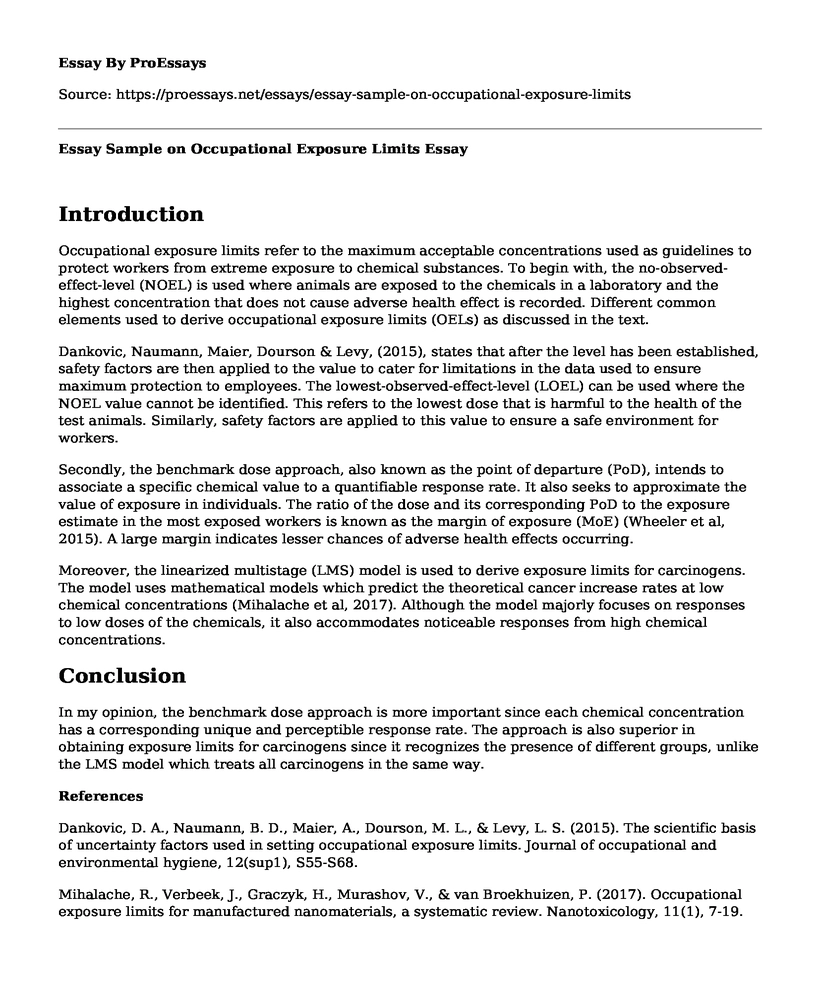Introduction
Occupational exposure limits refer to the maximum acceptable concentrations used as guidelines to protect workers from extreme exposure to chemical substances. To begin with, the no-observed-effect-level (NOEL) is used where animals are exposed to the chemicals in a laboratory and the highest concentration that does not cause adverse health effect is recorded. Different common elements used to derive occupational exposure limits (OELs) as discussed in the text.
Dankovic, Naumann, Maier, Dourson & Levy, (2015), states that after the level has been established, safety factors are then applied to the value to cater for limitations in the data used to ensure maximum protection to employees. The lowest-observed-effect-level (LOEL) can be used where the NOEL value cannot be identified. This refers to the lowest dose that is harmful to the health of the test animals. Similarly, safety factors are applied to this value to ensure a safe environment for workers.
Secondly, the benchmark dose approach, also known as the point of departure (PoD), intends to associate a specific chemical value to a quantifiable response rate. It also seeks to approximate the value of exposure in individuals. The ratio of the dose and its corresponding PoD to the exposure estimate in the most exposed workers is known as the margin of exposure (MoE) (Wheeler et al, 2015). A large margin indicates lesser chances of adverse health effects occurring.
Moreover, the linearized multistage (LMS) model is used to derive exposure limits for carcinogens. The model uses mathematical models which predict the theoretical cancer increase rates at low chemical concentrations (Mihalache et al, 2017). Although the model majorly focuses on responses to low doses of the chemicals, it also accommodates noticeable responses from high chemical concentrations.
Conclusion
In my opinion, the benchmark dose approach is more important since each chemical concentration has a corresponding unique and perceptible response rate. The approach is also superior in obtaining exposure limits for carcinogens since it recognizes the presence of different groups, unlike the LMS model which treats all carcinogens in the same way.
References
Dankovic, D. A., Naumann, B. D., Maier, A., Dourson, M. L., & Levy, L. S. (2015). The scientific basis of uncertainty factors used in setting occupational exposure limits. Journal of occupational and environmental hygiene, 12(sup1), S55-S68.
Mihalache, R., Verbeek, J., Graczyk, H., Murashov, V., & van Broekhuizen, P. (2017). Occupational exposure limits for manufactured nanomaterials, a systematic review. Nanotoxicology, 11(1), 7-19.
Wheeler, M. W., Park, R. M., Bailer, A. J., & Whittaker, C. (2015). Historical context and recent advances in exposure-response estimation for deriving occupational exposure limits. Journal of occupational and environmental hygiene, 12(sup1), S7-S17.
Cite this page
Essay Sample on Occupational Exposure Limits. (2022, Nov 06). Retrieved from https://proessays.net/essays/essay-sample-on-occupational-exposure-limits
If you are the original author of this essay and no longer wish to have it published on the ProEssays website, please click below to request its removal:
- Questions and Answers on Impacts that Solvents and Noise Have on Hearing
- Should One Choose to Get Vaccination or Should the Government Enforce It
- Treatment of Physiological Changes Associated with Metabolic Syndrome - Paper Example
- Psychological and Social Aspects of Health Education Essay Example
- Evidence-Based Research in Health Care: CDC Policies & Guidelines - Essay Sample
- Paper Example on the Nursing Profession Demands
- Paper Sample on Minority Age Group Health Challenges in Pediatric Industry







